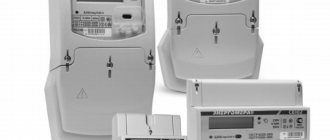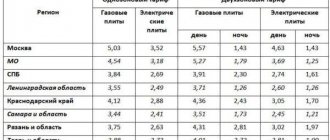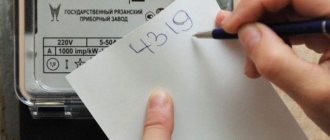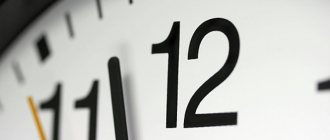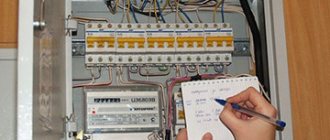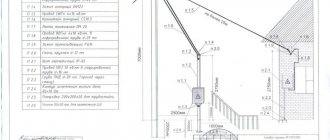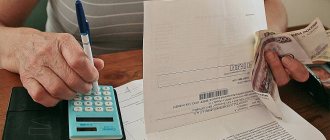- December 6, 2020
- Electricity
- Yulia Tolok
Every owner should know how to calculate electricity (calculate its consumption, in other words). In this case, electricity consumption refers to the amount of electrical energy that devices use to operate. You need to know its consumption in order to assess your purchasing power, avoid making mistakes when paying, and also evaluate what measures can be taken to improve energy efficiency and where you can save.
The total consumption of all devices that are connected to the network can be calculated using an individual meter. He will also answer the question of how to calculate the payment for electricity. A slightly more complicated situation is to calculate the consumption of an individual device.
Characteristics of electric current
The device passport may indicate various characteristics indicating its consumption, but most often these are supply voltage, current or power (usually at maximum load). Often the voltage is omitted, since it means that all goods produced on the territory of the Russian Federation or imported here are designed for a voltage of 220 V. In the USA, this parameter is 110-120 V.
From school physics courses, many remember that current is measured in amperes, voltage in volts, and power in watts. It is necessary to note that for more powerful devices the latter can be indicated in kilowatts, which are proportional to one thousand watts.
Sometimes the device's passport indicates electricity consumption, not power. It is important to pay attention to the period for which it is indicated; it could be a year, a month, a day, and so on. Electricity is paid in kW-hours, which is indicated as kWh. There is a common notation kW/hour or “kilowatt per hour”, which is incorrect when it comes to electricity consumed. In fact, these units measure the speed of construction of power plants. Sometimes a multiple of it, mW/year, is also found.
How to calculate electricity consumption for an apartment owner: 3 ways
I show 3 calculation technologies in order of complexity
The simplest method is an electric meter
The main role in electricity metering is played by the electric meter. It constantly converts the current flowing through it and the applied voltage into power, displaying them in an easy-to-read form.
Older induction meters use an electromechanical drive that operates by rotating an aluminum disk.
It has a rather vulnerable design from the point of view of electricity theft. It is attractive to dishonest people because it allows you to stop the counter or even make it rotate in the opposite direction in a fairly large number of ways.
Electricity meter
Electric meters today are found in almost every apartment or house. They help you pay exactly how much electricity is consumed and, if necessary, save it.
Previously, all electricity meters were mechanical. Their display looked like rotating drums with numbers that showed the amount of electricity consumed. Now this is a digital display with many additional functions, such as dividing consumption into tariff zones, calculating average consumption, indicating the presence of current in the network, and so on.
Using a meter, you can calculate the electricity consumption of a specific device. To do this, you need to turn off all other equipment in the house and leave only the one that interests you. Record the time, for example an hour. And see how many kW*hours the meter will “wind up”. If you calculate the time over a shorter period of time, then you should multiply these meter readings by the desired coefficient.
It should be noted that most devices consume less than 1 kWh. In this case, you should pay attention to the last digit, which is highlighted in red or after the decimal point. These are tenths. If you take them into account, the indicator will be more accurate.
Not all equipment constantly consumes the amount of electricity indicated in the passport. Depending on the operating mode, this number is usually lower. The refrigerator freezes only when the temperature rises above a predetermined interval, and the washing machine consumes more if the heating elements or pump are turned on, but is practically idle when the laundry is soaking. Energy consumption is calculated based on the power of each device and their total.
Table of Approximate Energy Use of Electrical Appliances
Have your electricity bills shocked you? Don’t know where these amounts come from? It seems that you don’t do a lot of laundry, and don’t turn on the lights in vain, but the counter inexorably adds up to high numbers. It might be worth finding out how much energy all your appliances actually consume.
Without a doubt, the most kilowatts come from household appliances that you use constantly. How can you find out which devices are more economical and which are not?
To calculate the electricity consumption of a specific device per unit of time, you need to pay attention to the following characteristics:
Directly the power of the device itself: the engine or power supply.
The amount of time the device operates.
Ambient temperature.
Of course, not in all cases the above factors play a significant role. But for some household appliances (for example, a refrigerator), every point is important. The following table of electricity consumption for household appliances will give an idea of the approximate consumption per month.
Calculation of power of electrical appliances
Determining the power of equipment is useful not only for calculating the energy consumed and saving it. It also helps to estimate the maximum load, and prevent fire if this number is exceeded.
Most device data sheets indicate power. If you multiply the indicated number in kW by the operating time, you can get the amount of electricity consumed. Next, it remains to figure out how to calculate electricity consumption based on the power of the equipment.
Let's say there are 2 light bulbs of 40 W each and a kettle with a power of 2.1 kW. The light bulbs work for 4 hours a day, and the kettle boils for 5 minutes. Let's say it is used 6 times a day. Then the light bulbs consume 320 W hours, and the kettle - 1.05 kW. The total consumption will be 1.37 kW.
Application of energy consumption calculations in practice
Let's look at examples of how you can calculate the kilowatts consumed over a certain period of time by one or another energy receiver(s).
Example 1. Calculate the monthly power consumption of a professional hair dryer for personal daily use.
Hair dryers used by professional hairdressers have impressive power. Let's say the rated power of our device is 2000 W. At the same time, one person uses it and spends about 10 minutes a day drying and styling their hair with it. Since the task does not contain specific information about how long the billing month lasts, we use the average number of days - 30.4. Thus, we have the following solution to the problem under consideration:
Example 2. Calculate the annual power consumption in a room in which the following items of electrical equipment are located and periodically used: TV, air conditioner, laptop.
At the same time, the owner of the room watches TV only in the morning, getting ready for work, and in the evening during dinner - a total of 1.5 hours a day. He works on his laptop in the evenings - about 2 hours a day. The air conditioner is used exclusively for cooling the air in the summer, and only 3 weeks in total are hot enough for this.
In the age of total visualization
Based on the above, we have:
Important! It should be borne in mind that not every energy-receiving device operates at full power in one mode or another. In particular, an air conditioner or refrigeration unit set to low cooling will consume power that will be lower than declared.
Converting amperes to kilowatts
In some cases, only one number may be indicated in the passport or on the device itself - current (amps). To get watts from this parameter, simply multiply it by voltage. If the voltage is not specified, then the value is 220 V (for devices designed for operation in Europe or Russia). This calculation method will be correct for most household electrical appliances.
It's worth noting that when you multiply volts by amps, you get watts, not kilowatts. To find out the value of the latter, you need to divide the resulting value by 1000.
What is power consumption?
Power consumption is a numerical measure of the amount of electrical energy required for the operation of an electrical appliance or converted by it during operation. For static devices (stove, iron, TV, lighting), current energy turns into heat during operation). During conversion (electric motors), the energy of electric current is converted into mechanical energy.
The basic unit of electrical power is Watt, its numerical value
where U is voltage, Volts, I is current, amperes.
Sometimes this parameter is indicated in V×A (V×A for imported equipment), which is more correct for alternating current. The difference between Watts and VA for household networks is small and can be ignored.
Electrical power consumption is important when planning wiring (the cross-section of the wires depends on it, as well as the choice of ratings and the number of circuit breakers). During operation, it determines the costs of maintaining the home.
Measuring consumption by the device
It will not be possible to find out exactly the real consumption using only the formula. You can use an electricity meter in principle. But the most convenient option is a special meter for the outlet. It is quite common and often found on sale; you can find it by its name - energy meter, or wattmeter.
Using such a measuring device, you can obtain the following data:
- cost of electricity consumption per month when setting tariffs;
- voltage and current at the moment;
- current power;
- consumption for a given period of time.
To start measuring, just plug the wattmeter into a power outlet. It also has a socket. The measuring devices are connected there. Once connected, power, voltage, current, consumption and other indicators will be displayed in real time, depending on the settings.
Direct current measurement
The methods of that group are characterized by higher accuracy due to the fact that they are based on direct measurement of current. There are two devices for performing this procedure at home.
Metering with current clamps
The most convenient to use are current clamps that do not require breaking the controlled circuit. Designed as a hand-held device with a measuring unit based on a toroidal core. To measure the current, the assembly is opened in the manner of pincer sponges, and then closed to cover the wire, Figure 3. The effective value of the current is determined by the change in the magnetic field, which is recorded by the Hall sensor.
Measurement with a tester
The second method is based on the use of a tester, which is switched to ammeter mode and connected to an open circuit. The difficulties of implementing this procedure using simple means make it little popular in practice. We also cannot discount the fact that some tester models do not have current protection and fail (burn out) if the range is incorrectly selected (current overload).
Computer
The main source of consumption is the system unit. It has a power supply installed, and once you know its power characteristics, you can estimate the approximate consumption. As a rule, this is 300-600 W. But this is the maximum power; it is unlikely that the computer will only consume even under full load.
Additionally, you need to take into account the monitor and other equipment, if it is turned on (printer, scanner, modem, speakers). In total, for an average computer, consumption is about 550 W (0.55 kW). But taking into account downtime and performing simple tasks, the average value is taken - 0.5 kW. It turns out that if you use a computer for 6 hours a day, then it consumes about 90 kWh per month. Accordingly, if the computer does not turn off around the clock, then its maximum monthly consumption will exceed 300 kWh.
Fridge
According to the technical data sheet of most refrigerators, they consume about 230-450 kWh per year. It is enough to divide this number by 12 to get a monthly consumption of about 20-30 kW. It will vary depending on the size of the refrigerator, the presence of a freezer, the density of the rubber bands, the presence of energy-saving modes and the food load. Also, to assess consumption, it is necessary to take into account external conditions. It will directly depend on the air temperature in the room.
TV
Consumption by TVs differs depending on their design and screen diagonal. So, for example, on average a small TV will “eat” 100 W, while a plasma with a large diagonal will already consume 300 W or even 500 W. You also need to take into account the time you watch TV, whether any additional devices are used (for example, receivers) and how many TVs are installed in the apartment. It is estimated that if the TV is turned on for about 4 hours a day, it consumes approximately 20-30 kWh monthly.
Washing machine
The consumption of a washing machine is usually specified in the passport. The numbers depend on the program and are indicated not for hourly consumption, but for the entire cycle. The power of an average device is 2-2.5 kW; in practice, 1.5 kW*hour is consumed per hour. When using a washing machine twice a week with a 2-hour cycle, you get about 20 kWh.
However, this figure will be higher if the washing machine has a drying mode, the family is large or there are small children.
Kettle and iron
These devices are considered the most expensive in terms of energy costs. Despite the fact that they do not work for long, the consumption for both devices is still about 30 kWh per month.
Not all appliances that consume electricity in the house are listed. Additionally, you will need to count such things as a multicooker, microwave oven, vacuum cleaner, phone chargers and others, if available. Maximum consumption is observed if an electric or induction stove, air conditioner, boiler or electric heaters are used.
Electricity consumers in the house
Decree of the Government of the Russian Federation No. 334 “On improving the procedure for technical connection of consumers to electrical networks” dated April 21, 2009 states that a private individual can connect up to 15 kW to his home. Based on this figure, we will make a calculation and see how many kilowatts will be enough for our home. To carry out the calculation, you need to know how much electricity each electrical appliance in the house consumes.
Power table of household electrical appliances
The power table for household electrical appliances shows approximate electricity consumption figures. Energy consumption depends on the power of the devices and the frequency of their use.
| Electrical appliance | Power consumption, W |
| Appliances | |
| Electric kettle | 900-2200 |
| Coffee machine | 1000-1200 |
| Toaster | 700-1500 |
| Dishwasher | 1800–2750 |
| Electric stove | 1900–4500 |
| Microwave | 800–1200 |
| Electric meat grinder | 700–1500 |
| Fridge | 300–800 |
| Radio | 20–50 |
| TV | 70–350 |
| Music Center | 200–500 |
| Computer | 300–600 |
| Oven | 1100–2500 |
| Electric lamp | 10–150 |
| Iron | 700–1700 |
| Air purifier | 50–300 |
| Heaters | 1000–2500 |
| Vacuum cleaner | 500–2100 |
| Boiler | 1100–2000 |
| Instantaneous water heater | 4000–6500 |
| Hairdryer | 500–2100 |
| Washing machine | 1800–2700 |
| Air conditioner | 1400–3100 |
| Fan | 20–200 |
| Power tools | |
| Drill | 500–1800 |
| Hammer | 700–2200 |
| Circular saw | 700–1900 |
| Electric planer | 500– 900 |
| Electric jigsaw | 350– 750 |
| Grinding machine | 900–2200 |
| A circular saw | 850–1600 |
Let's do a little calculation based on the data from the table of power consumption of household electrical appliances. For example, in our house there will be a minimum set of electrical appliances: lighting (150 W), refrigerator (500 W), microwave (1000 W), washing machine (2000 W), TV (200 W), computer (500 W), iron (1200 W), vacuum cleaner (1200 W), dishwasher (2000 W). In total, these devices will consume 8750 W, and given the fact that these devices will almost never be turned on at once, the resulting power can be divided in half.
Warm floor
This type of heating is considered one of the most economical, even if electricity is used for heating. However, consumption depends on many factors, such as operating mode, desired air temperature in the room, outdoor air temperature, types of coatings, and so on. It is believed that if a heated floor is used instead of the main heating device, then it consumes about 0.2 kW per 1 sq.m. per hour. m. If it is used only to maintain a comfortable temperature, in the presence of other heat sources, then this figure will be approximately half as much. In order to calculate the monthly consumption, it is necessary to multiply this figure by the heated area, daily operating time and the number of days in the month.
How and why to save energy based on data on electricity consumption of household appliances
There are at least two reasons why you need to save energy. This is saving natural resources and reducing harmful emissions into the atmosphere and reducing consumer expenses. Analyze how much electricity each appliance in your home consumes and whether this figure can be reduced. If the total consumption exceeds the average statistical norm of electricity consumption in Russia of 350 kW per person per month, it is enough to take simple measures. How you can save energy:
- the lights on unnecessarily ;
- if the electrical appliance is not in use, unplug it;
- use only energy-saving lamps , their high cost will quickly pay off, since they work much longer than simple incandescent lamps;
- set the computer to an economical standby mode , after a certain time the device will turn off automatically, and when switched to active mode, it will “eat” less electrical energy;
- do not leave windows open when the air conditioner is on, causing it to run idle;
- place the refrigerator and freezer away from the hot radiator and windows to protect from warm sunlight;
- defrost the refrigerator , as soon as ice has formed in the freezer, it increases electricity consumption;
- If possible, do not use adapters and extension cords;
- regularly remove scale from the kettle , it causes you to spend more electricity on heating;
- install multi-tariff meters to use energy-intensive equipment at night, when tariffs are almost twice as low.
Give preference to household appliances with a high energy efficiency class. Since 2011, all home appliances from refrigerators and washing machines to lamps are marked with special indices - A, B, C, D, E, F, G.
Household appliances marked A, A+ and A++ the least ; they are classified as energy saving class 1, saving up to 50-80% of electricity.
Classes B and C save from 10 to 50% . The remaining indices mean that electrical appliances save little or are energy-consuming .
Saving electricity is important for every family, because the cost of electricity is a heavy burden on the household budget. Knowing how to calculate the average daily electricity consumption for each appliance can help you reduce your costs.
Source
Cost of electricity consumption
To estimate the amount you will have to pay for electricity, you need to know the average cost for your region of residence. Let’s say this figure is 4 rubles per kW*hour.
Next, you should multiply the resulting number (from the monthly meter) by the price. For example: consuming 100 kWh of electricity per month will cost 400 rubles.
There are many online calculators that can help you calculate this figure more accurately. The cost may depend on some other criteria: the presence of a multi-tariff meter, benefits, total monthly consumption, and so on.
Energy Saving Tips
Having analyzed energy costs, many owners involuntarily wonder if it is possible to somehow reduce them? Typically, large consumption is affected by refrigerators and lamps.
To reduce the consumption of a refrigerator, it must be moved away from the wall so that it is better ventilated, or replaced with a new one with better consumption readings.
It is optimal to use energy-saving light bulbs. They come in two types: LED and mercury. The latter are cheaper, but less durable, have lower efficiency and require special disposal rules. LED lamps are the best option. Provided they are made with high quality, they last a long time, can be produced in different colors, adjustable power, and as a rule, the manufacturer gives them a long warranty.
How many kilowatts do you need to heat a house?
The main consumers of electric current in homes are lighting, cooking, heating and hot water.
During the cold season, it is important to pay attention to the heating of the house. Electric heating in a house can be of several types:
- water (batteries and boiler);
- purely electric (convector, heated floor);
- combined (warm floor, radiators and boiler).
Let's look at electric heating options and energy consumption.
- Heating using a boiler. If you plan to install an electric boiler, then the choice should fall on a three-phase boiler. The boiler system equally divides the electrical load into phases. Manufacturers produce boilers with different capacities. To choose the right one, you can make a simplified calculation by dividing the area of the house by 10. For example, if the house has an area of 120 m2, then for heating you will need a 12 kW boiler. To save on electricity, you need to install a two-tariff mode for using electricity. Then at night the boiler will operate at an economical rate. Also, in addition to the electric boiler, you need to install a buffer tank, which will accumulate warm water at night and distribute it to heating devices during the day.
- Convector heating. As a rule, convectors are installed under windows and connected directly to an outlet. Their number should correspond to the presence of windows in the room. Experts recommend calculating the total amount for the power consumption of all heating devices and equally distributing it across all three phases. For example, the heating of one floor can be connected to the first one. To another phase, the entire second floor. To the third phase, add a kitchen and a bathroom. Today, convectors have improved functions. This way you can set the desired temperature and choose the heating time. To save money, you can set the time and date of operation of the convector. The device has a “multi-tariff” option, which turns on the heater at the required power or at a reduced rate (after 23-00 and before 8-00). Energy calculations for convectors are similar to the boiler in the previous paragraph.
- Heating using underfloor heating. A very convenient heating option, as you can set the desired temperature for each room. It is not recommended to install heated floors in the place where furniture, refrigerators, and bathrooms are installed. Calculations show that a house of 90 m2 with an installed convector and heated floor on one floor consumes from 5.5 to 9 kW of electricity.
Tariffs depending on the time of day
Since energy consumption drops significantly at night, which complicates the operation of power plants, programs have been developed that allow you to pay less during the least busy period. This was done so that when installing a two- or three-tariff meter, people would use some of their electrical appliances at night and save money, while the load on the networks would be distributed more evenly.
In most regions there are two- or multi- (most often three-) tariff zones. In the first case (2-tariff zones), the cost of electricity at night falls by 2 times compared to the standard tariff. In the second, three tariff zones are distinguished. The first is night with a coefficient of 0.4. The second is half-peak with a coefficient of 1. The third is peak, with a coefficient of 1.5. Thus, for consumption in the night zone you need to pay 40% of the standard tariff, and in the peak zone - one and a half times more.
To use this type of tariffing, special electronic meters are required, in which meter readings are given separately for each zone. Some of them send the received data to the controller automatically, and, accordingly, the correct payment is received without the need to enter readings manually.
In order to understand how to calculate metered electricity consumed according to the principle of several tariffs, it is necessary to take the values for each tariff zone, multiply them by the standard tariff and by the normalization coefficient. The amount of consumption for all tariffs must be equal to the total consumption, which is also indicated on the meter.
The latter helps ensure that the calculations are made correctly.
How to take readings from three-phase meters
There are two types of three-phase electricity meters - the old type, which requires transformers, and electronic direct connection (without transformers). If an electronic one is installed, the electricity meter readings must be taken in the same way as described above. Simply write down the values, wait until the necessary information is displayed on the screen, or “scroll” the data to the required page.
Connecting an electric meter in a three-phase network via current transformers
If a large amount of power is allocated or an old-style meter is installed, a transformer is installed on each of the phases. To take readings in this case, you need to know the transformation ratio. The readings taken must be multiplied by this coefficient. The resulting figure will be the actual expense.
But in general, you need to read the contract. The calculation procedure must be prescribed there - in some organizations they write out readings, put down the transformer data or transformation ratio, and the actual calculations are made by the operator himself. So, if you have a 3-phase meter, check the form and procedure for calculations when installing and sealing the metering device and putting it into operation.


